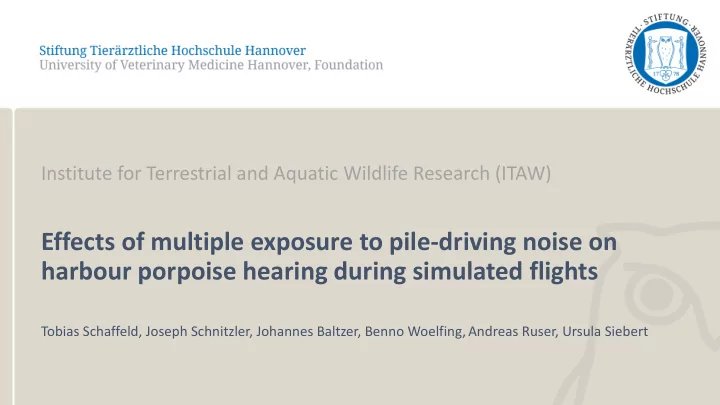

Institute for Terrestrial and Aquatic Wildlife Research (ITAW) Effects of multiple exposure to pile-driving noise on harbour porpoise hearing during simulated flights Tobias Schaffeld, Joseph Schnitzler, Johannes Baltzer, Benno Woelfing,Andreas Ruser, Ursula Siebert
The North Sea... https://commons.wikimedia.org/wiki/File:2012-05-13_Nordsee-Luftbilder_DSCF8888.jpg https://commons.wikimedia.org/wiki/File:Ecomare_-_bruinvis_Michael_in_2015_(bruinvis-michael2015-9313-sw).jpg • • considered vulnerable because of high by-catch The wind farms in the North Sea make an levels and increasing sound pollution. important contribution to achieving the European • protected by both national and EU law. renewable energy targets.
Temporary Threshold Shift (TTS) is regarded as injury Hearing threshold Elevated thresholds PTS Hearing threshold in dB 100 TTS Time 50 • TTS is regarded as injury and therefore prohibited by law Human hearing spectra 0 1 10 0.01 0.1 100 Frequency (kHz)
TTS risks of multiple pile-driving strikes: - Research on TTS has been focussed mainly on exposure to single impulsive sounds and little is known about the cumulative effects of exposure to intermittent sounds. - Experiments with bottlenose dolphins showed the potential for accumulation of SEL from multiple exposures and for recovery of hearing during the quiet intervals between exposures (Finneran et al. 2010).
TTS risks of multiple pile-driving strikes: - Research on TTS has been focussed mainly on exposure to single impulsive sounds and little is known about the cumulative effects of exposure to intermittent sounds. - Experiments with bottlenose dolphins showed the potential for accumulation of SEL from multiple exposures and for recovery of hearing during the quiet intervals between exposures (Finneran et al. 2010).
TTS risks of multiple pile-driving strikes: - Research on TTS has been focussed mainly on exposure to single impulsive sounds and little is known about the cumulative effects of exposure to intermittent sounds. - Experiments with bottlenose dolphins showed the potential for accumulation of SEL from multiple exposures and for recovery of hearing during the quiet intervals between exposures (Finneran et al. 2010).
TTS risks of multiple pile-driving strikes: - Research on TTS has been focussed mainly on exposure to single impulsive sounds and little is known about the cumulative effects of exposure to intermittent sounds. - Experiments with bottlenose dolphins showed the potential for accumulation of SEL from multiple exposures and for recovery of hearing during the quiet intervals between exposures (Finneran et al. 2010). - Recent studies on harbour porpoises showed that besides the danger from a single pulse with high energy, the reception of multiple pile-driving strikes with single strike sound exposure levels (SEL SS ) well below the legal threshold can also induce a TTS, because of the total received energy (Kastelein et al . 2015, 2016). TTS onset SEL cum 175 dB re 1 µPa²s Effective quiet SEL SS 145 dB re 1 µPa²s
Research area in the German North Sea
Calculated the sound propagation with a non linear regression
Calculation of a hazard radius where porpoises are at risk - The hazard radius corresponds maximum radius where a TTS can be induced from multiple pile-driving strikes above the effective quiet threshold - We determined a safe distance using the slope, intercept and the absorption coefficient of the modelled sound propagation along with the effective quiet threshold within the following equation: 𝑡𝑚𝑝𝑞𝑓 −𝑗𝑜𝑢𝑓𝑠𝑑𝑓𝑞𝑢 𝐹𝑅𝑈 ቁ 𝑡𝑚𝑝𝑞𝑓 10 × 𝛽 × lo g( 10 𝛽 × 𝑋( 𝑡𝑚𝑝𝑞𝑓 𝑡𝑏𝑔𝑓 𝑒𝑗𝑡𝑢𝑏𝑜𝑑𝑓 = ሻ 𝑗𝑜𝑢𝑓𝑠𝑑𝑓𝑞𝑢 × lo g( 10
Radii of hazard zones around a pile-driving site - The hazard radius corresponds to the maximum radius where a TTS can be induced from multiple pile-driving strikes above the effective quiet threshold is at 5.4 Km - according to an assumed pulse interval of 1.3 s, the SELcum value would exceed the TTS onset of 175 dB re 1 μ Pa²s after 1001 single pile strikes within 21.7 minutes.
Risk for a fleeing porpoise: - In contrast to direct effects on hearing, behavioural reactions of free-ranging harbour porpoises to pile-driving strikes are not fully understood yet. Harbour porpoise flights were simulated at a swimming speed of 0.9, 3.3, 4.3 and 6.1 m s -1 . - - The received SEL cum for the complete track of a harbour porpoise swimming straight away from the sound source from a specific position, up to the safe distance is given by following equation: 1 10 × 𝑗𝑜𝑢𝑓𝑠𝑑𝑓𝑞𝑢 × (𝑡𝑏𝑔𝑓 𝑒𝑗𝑡𝑢𝑏𝑜𝑑𝑓 𝑡𝑚𝑝𝑞𝑓+1 − 𝑡𝑢𝑏𝑠𝑢 𝑒𝑗𝑡𝑢𝑏𝑜𝑑𝑓 𝑡𝑚𝑝𝑞𝑓+1 ቁ 10 𝑇𝐹𝑀 𝑑𝑣𝑛 = 10 × 𝑚𝑝 10 𝑞𝑣𝑚𝑡𝑓 𝑗𝑜𝑢𝑓𝑠𝑤𝑏𝑚 × 𝑡𝑞𝑓𝑓𝑒 × (1 + 𝑡𝑚𝑝𝑞𝑓 ൰ 10
Risk for a fleeing porpoise:
Risk for a fleeing porpoise:
Ecological relevance of disturbance TTS = The acoustical perception of the environment is of key importance for harbour porpoises to navigate (Villadsgaard et al., 2007), find and catch prey items (DeRuiter et al., 2009; Wisniewska et al., 2016) and intra-specific communication (Clausen et al., 2010; Sørensen et al., 2018) and any impairment could potentially negatively affect individual fitness, reproduction or survival.
Ecological relevance of disturbance TTS = The acoustical perception of the environment is of key importance for harbour porpoises to navigate (Villadsgaard et al., 2007), find and catch prey items (DeRuiter et al., 2009; Wisniewska et al., 2016) and intra-specific communication (Clausen et al., 2010; Sørensen et al., 2018) and any impairment could potentially negatively affect individual fitness, reproduction or survival. Energetic costs = The resulting drag from moving in a medium increases with the square of swim speed and likewise the needed costs of locomotion for propulsion against the drag (Gallagher et al., 2018; van der Hoop et al., 2014). Harbour porpoises are living on an energetic knife edge, which makes them particularly vulnerable to anthropogenic disturbance (Wisniewska et al., 2016).
Conclusion Only the combination of: - Noise mitigation, - Previous deterrence effort and - A soft start phase can ensure that a porpoise escapes a TTS.
Thanks for your attention!
Recommend
More recommend